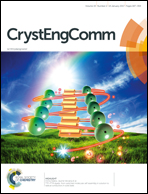Experimental and theoretical second harmonic generation and photoluminescence from the pseudo-centrosymmetric dihydrochloride salt dihydrate of trans-1,2-bis(4-pyridyl)ethene†
Abstract
Here we have prepared a dihydrochloride salt dihydrate of the well-known trans-1,2-bis(4-pyridyl)ethene (BPE) featuring both photoluminescent and nonlinear optical properties. In its triclinic lattice (space group P1), BPE cations are stacked face-to-tail through π⋯π interactions between the spacer double-bonded carbons and the protonated pyridyl ring, with a slippage of 3.45 Å always towards the same direction, which is common in other NLO crystals. The existence of inversion symmetry was suggested in its crystal structure, which was ruled out by the SHG emission centred at 487 nm upon excitation at 974 nm. While the fully optimized single molecule of the divalent BPE cation in the gas phase had almost null μ, βtot, βCT and βvec values calculated at the CAM-B3LYP/NLO-V//B3LYP/6-31G* level of theory, these values differed from zero in the crystal conformation. More interestingly, a ca. 4-fold increase in βtot, α and μ was observed for the π⋯π stacked four-molecules as found in its crystal structure. Lastly, this BPE material presents high photoluminescence emission centred at 425 nm under excitation at 366 nm, being therefore a multifunctional optical crystal form.



 Please wait while we load your content...
Please wait while we load your content...